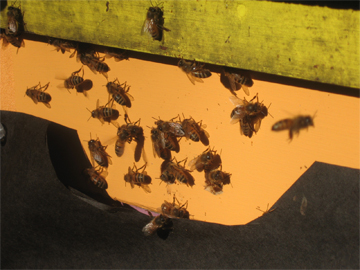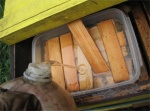A robin crossed my path a few days ago. The alders are displaying their still closed catkins. The chickadees have been singing for a few weeks. Spring is coming. The crocuses usually follow the robins by 2 weeks. About 6 weeks later, the big leaf maples bloom. This is important to me: it’s the first big nectar flow of the year.
Then a friend in Seattle was asking the other day when he should start feeding his bees. I hear cries of “never” coming from some of you, but I feed and he feeds, so we face this question: When is the best date to start.
Start too early and you wind up with a lot of field bees with nothing to do. This, in turn, may retard the queen’s laying, so that you field force is diminished when the nectar flow hits. Start too late, and you don’t have enough field bees to take full advantage of the honey flow.
Dates and Figures:
It takes 3 weeks for an egg to become a worker. Then it will, usually take about 3 more weeks before that little lady becomes a forager. So, if one wants to have a booming work force on the first honey flow of the year 7 to 8 weeks before the first flow is the start date for feeding. The extra week(s) is because you need some time for the bees to realize there is food available and for the queen to kick into high egg-laying gear.
Of course nothing is perfect in nature. By my calendar 2 years ago, the big leaf maples bloomed in the first week of April. Last year it was the third week. So, had I fed last year on the bases of the previous year, I would have had a lot of hungry bees flying about for 2 weeks looking for food. Which would have meant two more weeks of feeding.
The timing can be missed the other way too: waiting to feed for a bee build-up, then having the bloom come when you don’t have a full work force. Farming wild is fun, isn’t it?
Options:
Start feeding 8 weeks before the first big bloom or pollination contract. That way if the bloom comes early a field force will be in place. If you’re pollinating, you will be assured a good number of foragers.
Start feeding 6 weeks before the first big bloom, hope it does not come too soon, and know that you won’t have a full field force until at least the 2nd week of the bloom (if it comes “on schedule” – ha)
Start feeding 3 weeks before the bloom. This will do nothing for a field crew. However, if you are feeding essential oils it will get some into the bees before you must stop feeding because they’re bringing in nectar.
Don’t feed at all. Let nature take its course. The bees will be eating natural honey and pollen, which really is better for them, as long as they have stores. You won’t get as much honey, which if you’re selling honey for a living, is not good for you, and thus not good for the bees who need you. It’s all symbiotic.
How do you know when you need the field force?
Aiming to hit a wild honey flow is a bit harder than meeting a pollination contract. Nature is just does not run to an exact schedule. If you’ve been keeping bees for a few years, you probably have a written record of when your primary nectar species bloom. My list is scrolled down the side of each year’s wall calendar. It’s an easy way to quickly look from one year to the previous years.
First year beekeeping is a bit harder. You may not have noticed when blooms occur. In large urban areas, your local garden clubs are the best answer. In cities that lie near countryside, you can ask the local agricultural extension folks, and the garden clubs. In croplands, the local farmers will know. In the forests, you might try a local birding or mushroom club. Those folks are out nearly year-round here and they see what’s around them. But before you ask, do the homework: what do bees go to in your area? Ask about specific plants. And remember, all these people can only give a best estimate.
What to feed?
Honey and pollen are the best. I don’t have any left, so it’s cane sugar syrup, with essential oils, and pollen substitute, made with cane sugar syrup and essential oils. Some people make a thin honey syrup, but I hear that can go off on you. There are beet sugar and high fructose corn syrup, but I won’t suggest them. I have heard the first is all GM now, with built in pesticides, and the latter I would not feed to me or any other creature (oh I do miss Mountain Dew….). Regardless of ones choices, both a sugar feed and a pollen or pollen substitute need should be provided if one feeds.
Issues:
If you do decide to feed, and decide on a date to start, there are still issues. Putting liquid feed into hives in the late winter – early spring is rife with potential problems, especially here in northwest Washington:
With in-hive feeders:
Snow and cold snaps can still come: if the daytime temperatures drop below 40F my bees won’t take the syrup. It’s too cold to move to it.
Water in the hive: Syrup, be it sugar or honey, has water in it. The last thing the bees need if the weather gets colder or torrential rains come is more water vapor drifting around the hive.
Losing the added insulation (this is probably only applicable to me): my feeders occupy the same space as the winter insulation. It’s either feed or a layer of insulation for my bees.
With external feeders:
Unless it’s sunny, the feeders will just sit there. Mice may come by – which makes the bee hive guard kitties very happy, but it does nothing for the bees.
A Balance
Me? I figure that at the farm and some up-river bee yards. I’ll set out some feed in external feeders. If the bees fly, they can find a little something, which might encourage laying. In two weeks the weather should lighten and the natural progression of laying will start to produce a larger cluster. Then I’ll place the internal feeders in the hive. It’s looking like a warm late-winter/spring, and it sure would be nice to have the girls in full force when the maples burst forth. We shall see, and I’ll let you know.
That’s the news this week from Brookfield Farm, Maple Falls, Washington…
Are you spring feeding? If so, how do you judge when to start? If not, do you find that the bees build up enough without your help? Do share, the more we share the more we can all learn.






2 Responses to To Feed or Not To Feed and When To Feed?